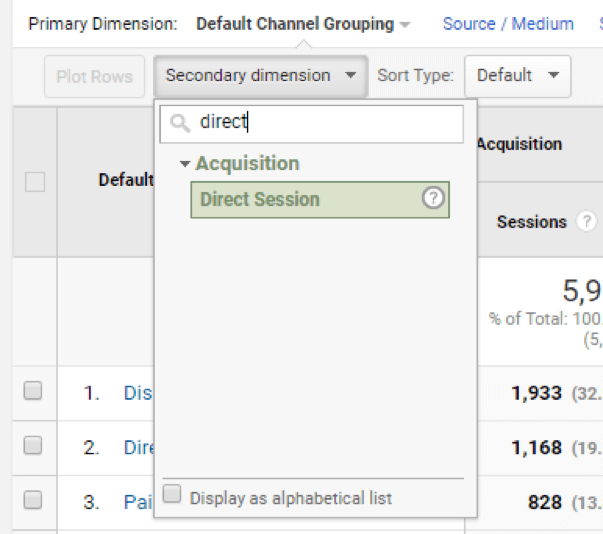Just How to Use Secondary Dimension in Google Analytics for Deeper Insights
Just How to Use Secondary Dimension in Google Analytics for Deeper Insights
Blog Article
Enhance Your Data Evaluation Making Use Of Secondary Dimension in Google Analytics
Checking out the abilities of second dimensions in Google Analytics opens up a world of opportunities for refining data evaluation. By layering additional measurements onto key information sets, a more complex story emerges, shedding light on individual interactions and efficiency indications.
Understanding Additional Measurements
Secondary dimensions in Google Analytics refer to extra parameters that can be added to the main dimension, allowing for a more comprehensive evaluation of data (Secondary Dimension in Google Analytics). By integrating second measurements, experts can section and filter information to discover patterns, fads, and connections that could not be obvious when looking at the information as a whole.

Benefits of Using Second Dimensions
When evaluating data in Google Analytics, the use of second dimensions offers indispensable understandings right into customer actions and performance metrics. By including a secondary dimension to your primary information, you can dig deeper into the features of your web site visitors and their communications.
Moreover, additional dimensions help in determining patterns and relationships that might not be promptly evident when checking out the data in seclusion. This much deeper level of evaluation can uncover valuable information that can direct marketing approaches, site optimization, and overall organization decisions. In addition, additional measurements boost the context of your main information, supplying a more comprehensive sight of customer interaction and efficiency metrics. Generally, the usage of secondary measurements in Google Analytics can considerably improve the deepness and high quality of your information evaluation, causing more educated decision-making and boosted outcomes.
Just How to Include Additional Measurements
By including second measurements in Google Analytics, customers can gain deeper insights into their data evaluation procedure, permitting even more comprehensive examination of customer actions and performance metrics. Adding second measurements is an uncomplicated procedure that can significantly boost the deepness of evaluation. To include an additional dimension in Google Analytics, begin by navigating to the report you intend to evaluate. As soon as in the report, find the "Second dimension" tab above the data table. Click it to expose a dropdown food selection with various options such as Actions, Modern Technology, and Personalized Capacities. Select the dimension you intend to add, such as 'Source/Medium' or 'Gadget Classification'. This secondary dimension will after that be related to your existing information, supplying extra context and permitting an extra thorough evaluation of user interactions. By utilizing additional dimensions efficiently, customers can discover beneficial insights that might have otherwise been ignored, resulting in educated decision-making and improved performance approaches.
Analyzing Information With Second Measurements
Utilizing secondary measurements in data analysis offers a much more detailed understanding of customer actions and performance metrics. By including an additional dimension to your primary information embeded in Google Analytics, you can dive much deeper right into the characteristics of your web site site visitors and their communications. Integrating the main dimension click of 'source/medium' with the additional dimension of 'landing web page' can disclose which certain web pages are bring in website traffic from different sources, helping you maximize these web pages for far better involvement.

In significance, analyzing data with secondary measurements empowers you to gain beneficial insights into individual behavior, recognize patterns, and make informed choices to improve the performance of your electronic residential or commercial properties.
Finest Practices for Secondary Measurements
In data analysis, including secondary dimensions effectively can dramatically boost the depth of understandings originated from metrics and user actions patterns. When utilizing second dimensions in Google Analytics or any type of various other logical device, it is essential to abide by finest practices to guarantee the precision and importance of the data analysis.
One secret ideal practice is to navigate to this site thoroughly pick secondary dimensions that match the key measurement being analyzed. Picking second measurements that provide added context or more division can offer a much more comprehensive understanding of the data. It is additionally vital to stay clear of overcomplicating the evaluation by including way too many secondary measurements, which may cause complication or dilution of understandings.
Moreover, it is advisable to experiment with various combinations of second and main dimensions to discover brand-new connections and fads. Regularly refining the option and reviewing of secondary measurements based on the certain goals of the analysis can result in even pop over to this web-site more actionable understandings. By adhering to these ideal techniques, information analysts can utilize additional measurements efficiently to boost the overall information analysis process and decision-making abilities.

Final Thought
To conclude, integrating additional dimensions in Google Analytics is essential for an extensive information analysis approach. By leveraging secondary measurements along with primary ones, experts and marketers can uncover important insights and correlations that can inform decision-making and maximize electronic marketing methods. Recognizing just how to successfully make use of additional dimensions and complying with best practices will allow professionals to extract meaningful data and enhance their general performance metrics.
Secondary measurements in Google Analytics refer to extra specifications that can be included to the key measurement, allowing for a more in-depth analysis of information. By integrating secondary dimensions, analysts can segment and filter data to discover patterns, patterns, and relationships that may not be obvious when looking at the information as a whole. Incorporating the key measurement of 'source/medium' with the second dimension of 'landing web page' can expose which specific web pages are attracting website traffic from various resources, assisting you enhance these pages for better engagement.
One key finest technique is to meticulously select second dimensions that complement the main measurement being assessed. By following these finest techniques, data analysts can take advantage of second dimensions properly to enhance the general information evaluation procedure and decision-making abilities.
Report this page